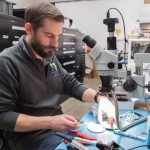5 Innovative Medical Devices Shaping Patient Care
In Blog
5 Innovative Medical Devices Shaping Patient Care2023-08-012024-09-23https://nextern.com/wp-content/uploads/2018/09/nextern-mainlogo-250px-2x.pngNexternhttps://nextern.com/wp-content/uploads/2023/08/nextern-8-9-23-blog.jpg200px200px
The medical device industry is constantly evolving. Rarely do engineers see a project and consider it finished. Instead, they constantly seek new ways to enhance a device to improve the user experience, optimize the efficiency and accuracy of the instrument or deliver increasingly better patient-centered care.
New medical technology, and improvements on existing devices, is always in the works. As engineers implement the use of 3D printing, AI, precision laser cutting and other enhanced capabilities, they are able to create innovative medical devices that keep the patient at the focus.
Here are five innovative medical devices that are already making a difference in the lives of patients and caregivers.
Insulin Delivery Systems
Patients with diabetes have seen huge strides in the treatments that have become available to them. Historically, insulin delivery systems were an incredibly involved process, with multiple devices and needle pricks required each day. New insulin delivery systems have streamlined the ability to monitor a patient’s blood sugars and adjust the amount of insulin being delivered into the patient in real-time with a single device. Patients can use this new medical technology to consolidate the number of devices they need to carry around, and they do not need to receive as many pricks or injections daily. New insulin delivery systems are the epitome of patient-centered care, as it is now easier to treat diabetes in a way that prioritizes real patient experiences and makes life easier and more comfortable.Breast Cancer Inhibitors
Approximately 1 in 8 women will develop breast cancer sometime in their life. As the most common form of cancer among women, doctors and scientists are always looking for ways to improve the treatment of cancer, as well as to prevent a diagnosis in the first place. The development of aromatase inhibitors (AIs) have changed the way physicians see and treat breast cancer among patients. In fact, AIs have proven to lower estrogen levels that can lead to the growth of breast cancer cells. Ongoing research and development are continuing to target the underlying causes of cancers in patients, and aromatase inhibitors are leading the way to achieve this. New medical technology, including medication such as AIs, offer patients and families a new peace of mind, especially for patients who are typically more at-risk for breast cancer and other common diseases.3D Printed Tissues and Organic Parts
While 3D printing technology has been used in medical device manufacturing for years now, the capabilities have quickly expanded to incorporate biocompatible devices and organic components that can fill in areas as needed. Patient-centered care is aligning with new technologies to augment treatments in ways never thought possible. For example, tissue can be bioprinted to enhance STEM cell research, modify muscle and joint connectivity and reinforce efforts in lab research and transplant operations. This directly provides opportunities for innovative medical devices to be developed, while also indirectly improving patient care by catapulting research capabilities to new possibilities and a greater understanding of tissue and organic systems without interfering with patient treatments.Easy-Access Catheters
Structural developments for catheters and intravenous instruments require a refined understanding of metal alloys and post-processing to ensure they are easy-access, biocompatible and low-profile. These catheters, stents and tubes have become increasingly refined and catered to both the patient and caregiver experience. New medical technology, including precision laser cutting and post-processing steps, enable engineers to create instruments with a more exact finish. This has resulted in easier access for nurses and doctors, and a less-invasive and painful experience for patients.Remote Patient Monitoring
Wearable devices that can track and record a patient’s activity and health are making waves in patient-centered care. Offering telehealth options and providing wearable devices enables patients to receive clinic-quality care from the comfort of their homes. Remote patient monitoring has increased in popularity and efficacy in recent years. New medical technology has made it a viable alternative to patients who need to complete regular therapy, need quick check-ins with their providers or who live in more rural areas. Accessible medicine and care can make all the difference in a patient’s treatment and long-term health.Innovating the Next Generation of Health Care
Medical technology and innovative medical devices are evolving every day. With enhancements in development approaches, including through the use of 3D printing and remote technology, engineers are able to create state-of-the-art products more quickly and with a higher quality than ever before. At Nextern, we are leading the way to improving patient care through innovative technology and world-class medical devices and instruments. Our team of developers and engineers work side-by-side to deliver your project to market. Create the next generation of medical devices and make a difference in the world around you. Contact us today.Follow us on linkedin!
Recent Posts






